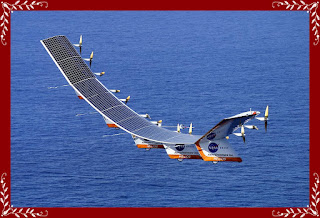The NASA Centurion was a modifying into the Helios Prototype configurations by adding a 6th 41 feet (12m) feather part and a 5th landing gear and systems pod, Suitable the 4th Configuration in the series of solar-powered flying feather exhibitor aircraft developed by Aero Vironment Under the ERAST project.
The larger feather on the Helios Prototype compromises more solar arrays to provide adequate power for the sun-powered development flight that followed. The aircraft's virgin flight was on September 8, 1999.
Descriptions of First Solar Flight Airplane :
Helios Prototype flings feather moments after the takeoff, beginning its 1st test flight on solar power from the U.S. Navy's Pacific Missile Range Facility (PMRF) on Kauai, Hawaii, July 14, 2001. The Helios Prototype is an ultra-lightweight flings feather aircraft with a wingspan of 247' ft (75 m), longer than the wingspans of the U.S.A. Air Force C-5 military transports (222' feet (68 m) or the Boeing-747 (195' ft (59 m) or 224' ft (68 m), depend on the model), the 2 largest operational aircraft built in the United States (USA).The electrical powered Helios is constructed mostly of composite elements such as carbon fiber, graphite epoxy, Kevlar, styrofoam, and a thin, diaphanous plastics skin. The main cylindrical feather spar is made of carbon fiber. The spar, which is frequent on the top and bottom to absorbed the constant bending motions that occur during flight, is also wrapped with Nomex and Kevlar for extra strengthening.
The feather ribs are also made of epoxy and carbon fiber. Shap styrofoam is used for the feather's leading edge and a durable clear plastic film covers the entire feather.

Blogger Comment
Facebook Comment